Kanchanaburi is a small quiet town in west-central Thailand, known mainly for it’s leading role during the Japanese invasion in World War II, when over two hundred thousand Allied and Asian prisoners of war were forced to build the Death Railway. It’s most emblematic element, the famous Bridge over the River Kwai, is located in Kanchanaburi town. Besides other places of interest related to that historical episode, this town offers a splendid riverside location, several markets with authentic local flavor, beautiful Buddhist monasteries and a languid provincial town atmosphere that invites to take things easy.
Conveniently located only about 120 km west of Bangkok, it is an easy getaway from the Thai capital. If you have time enough, in the surrounding area there’s National Parks with some of the most beautiful waterfalls in all of Thailand, hilltop temples with splendid views, and historical sites associated with the construction of the infamous Death Railway.
ℹ️ Top Things to Do in Kanchanaburi
The Bridge on the River Kwai
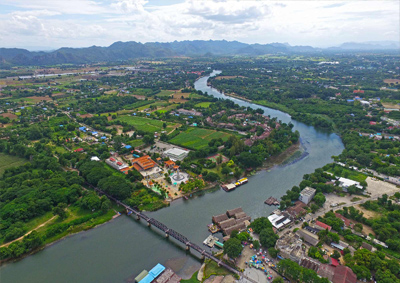 Located within the city itself, the Bridge over the River Kwai is both the city’s most famous tourist attraction and the main symbol of Kanchanaburi. Manage your expectations: the main interest here is its historical relevance, even though the place certainly has its charm. This bridge was a key point of the railway line that Japanese forced Allied and Asian prisoners to build during World War II. The bridge, surrounded by souvenir stalls and restaurants, is easily walkable, and it’s possible as well to take a small longtail boat to navigate around it, or to take the train from Kanchanaburi Central Station to Saphan Kwai Yai Station so you can cross the bridge on board the train.
Located within the city itself, the Bridge over the River Kwai is both the city’s most famous tourist attraction and the main symbol of Kanchanaburi. Manage your expectations: the main interest here is its historical relevance, even though the place certainly has its charm. This bridge was a key point of the railway line that Japanese forced Allied and Asian prisoners to build during World War II. The bridge, surrounded by souvenir stalls and restaurants, is easily walkable, and it’s possible as well to take a small longtail boat to navigate around it, or to take the train from Kanchanaburi Central Station to Saphan Kwai Yai Station so you can cross the bridge on board the train.
Death Railway Museum
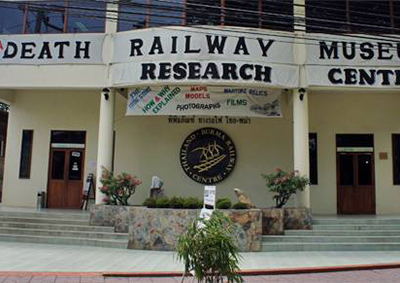
The Death Railway Museum is the best museum in the city to learn about the history of the Death Railway and the prisoners who built it. In its exhibition halls you’ll find prisoner objects, tools used to build the railway, railway parts, maps and videos. If you don’t have enough with this museum, you can continue with the JEATH War Museum, a smaller museum that details how was daily life for the prisoners during the building of the railway. The museum was created in 1977 by an abbot from Wat Chaichumpon monastery, which is located next door and you can visit as well. The pictures and paintings that make up the exhibition are displayed in wooden and bamboo structures, which aim to recreate the simple barracks where prisoners slept.
Wat Tham Suea and Wat Tham Khao
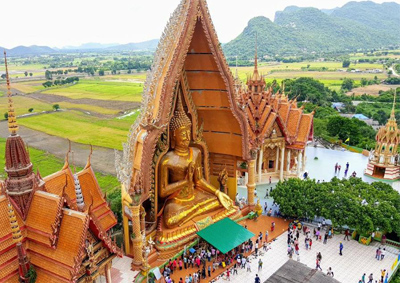 This two beautiful and large temples are so close to each other that they seem to be the same, but actually they are not. Wat Tham Suea and Wat Tham Khao Noi are 2 separated temples that can be easily visited together in a couple of hours. If you visit them you will find huge Buddhas and large pagodas that, from its top, offer nice views of its surroundings. They are an interesting visit if you are going to spend time exploring the area by bike, motorcycle or car. This 2 temples are located about 20 km from the city center.
This two beautiful and large temples are so close to each other that they seem to be the same, but actually they are not. Wat Tham Suea and Wat Tham Khao Noi are 2 separated temples that can be easily visited together in a couple of hours. If you visit them you will find huge Buddhas and large pagodas that, from its top, offer nice views of its surroundings. They are an interesting visit if you are going to spend time exploring the area by bike, motorcycle or car. This 2 temples are located about 20 km from the city center.
Hellfire Pass
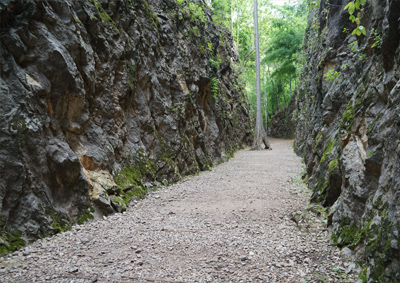 Hellfire Pass is the name by which is known the most callenging stretch of the Death Railway, in a mountainous area where the rock had to be dynamited and chiseled to open a pass. War prisoners were forced to work daily 16-18 hour shifts, with little water and only a small portion of rice for food, and many of them died of accidents, exhaustion, illness or beatings. In 1987 a memorial was erected here, and a museum was inaugurated in 1996, although the best thing to do here is to walk along the original railway path and climb to the viewpoint to admire the impressive over-100-metres-long and 17-meters-deep corridor. Hell Pass is located about 80 km west of Kanchanaburi, and access is free, although donations are accepted.
Hellfire Pass is the name by which is known the most callenging stretch of the Death Railway, in a mountainous area where the rock had to be dynamited and chiseled to open a pass. War prisoners were forced to work daily 16-18 hour shifts, with little water and only a small portion of rice for food, and many of them died of accidents, exhaustion, illness or beatings. In 1987 a memorial was erected here, and a museum was inaugurated in 1996, although the best thing to do here is to walk along the original railway path and climb to the viewpoint to admire the impressive over-100-metres-long and 17-meters-deep corridor. Hell Pass is located about 80 km west of Kanchanaburi, and access is free, although donations are accepted.
Ride on the Death Railway
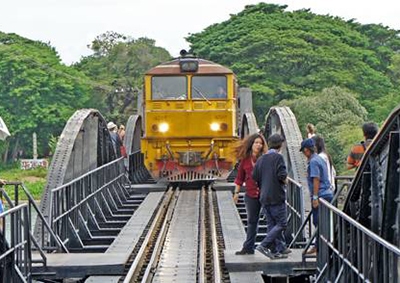 This day trip will allow you to enjoy a two-hour train journey along the original route of the Death Railway, which offers beautiful views over the region, and at the end of the journey, in Nam Tok village, you can get off and walk about 2 km to beautiful Sai Yok Noi waterfall, take a dip and eat at one of the local riverside restaurants in true Thai style. Sai Yok Noi Waterfall is located at the southern end of the Sai Yok and Erawan National Parks, right between them, about 63 km northwest of Kanchanaburi.
This day trip will allow you to enjoy a two-hour train journey along the original route of the Death Railway, which offers beautiful views over the region, and at the end of the journey, in Nam Tok village, you can get off and walk about 2 km to beautiful Sai Yok Noi waterfall, take a dip and eat at one of the local riverside restaurants in true Thai style. Sai Yok Noi Waterfall is located at the southern end of the Sai Yok and Erawan National Parks, right between them, about 63 km northwest of Kanchanaburi.
Erawan Waterfall
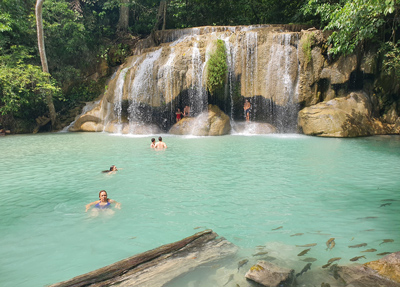 Erawan Waterfall is the most famous – and many would say most beautiful – in all of Thailand. It is located within the Erawan National Park, about 65 km northwest of Kanchanaburi. The water from the spectacular main drop follows its course forming clear natural pools in seven successive tiers, next to a path that allows the you to reach every stretch of this piece of paradise and choose your favourite spot to take a dip. As common, beauty has taken its toll, and the place tends to get crowded with tourists, although the river is quite long and usually it’s not too hard to find a spot for a quiet splash. The entrance fee to the Park is THB 300.
Erawan Waterfall is the most famous – and many would say most beautiful – in all of Thailand. It is located within the Erawan National Park, about 65 km northwest of Kanchanaburi. The water from the spectacular main drop follows its course forming clear natural pools in seven successive tiers, next to a path that allows the you to reach every stretch of this piece of paradise and choose your favourite spot to take a dip. As common, beauty has taken its toll, and the place tends to get crowded with tourists, although the river is quite long and usually it’s not too hard to find a spot for a quiet splash. The entrance fee to the Park is THB 300.
Allied Cemeteries
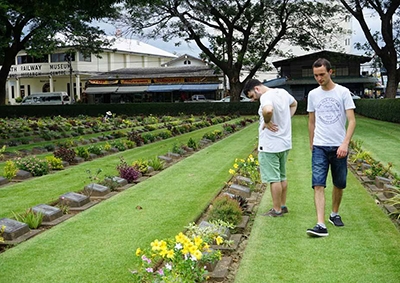 In Kanchanaburi there are two main cemeteries for the thousands of slave workers who died during the construction of the Death Railway. On the tombstones you can read their names, nationalities, ranks, ages and epitaphs. It is shocking to see that most of them were young men in their twenties, many of them Australian, Dutch and British. The cemetery is very well kept, and every year is visited by relatives and the few living survivors of that episode. One of the cemeteries is opposite the Death Railway Museum, while the other, Chung Kai War Cemetery, is on the west bank about 2 km outside the city.
In Kanchanaburi there are two main cemeteries for the thousands of slave workers who died during the construction of the Death Railway. On the tombstones you can read their names, nationalities, ranks, ages and epitaphs. It is shocking to see that most of them were young men in their twenties, many of them Australian, Dutch and British. The cemetery is very well kept, and every year is visited by relatives and the few living survivors of that episode. One of the cemeteries is opposite the Death Railway Museum, while the other, Chung Kai War Cemetery, is on the west bank about 2 km outside the city.
Prasat Meuang Singh
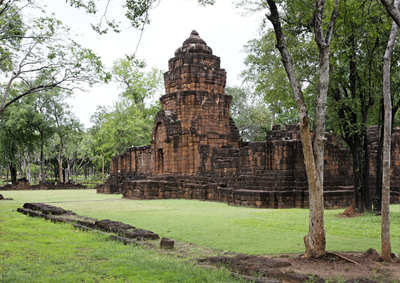 The ancient Prasat Meuang Singh, in the middle of a forested area about 35 km west of Kanchanaburi, are the westernmost Khmer ruins discovered so far. Although they are more modest than those in Phanom Rung or Phimai -eastern Thailand-, this charming historical site is well worth a trip from Kanchanaburi, even for those without a special interest in history. This 13th century shrine is believed to have been the center of one of the 23 major satellite cities scattered throughout the Angkor empire. As common in Khmer temples, the design of the sanctuary symbolizes Mount Meru, the mythical mountain in the center of Buddhist universe. Opening hours 08:00 to 16:30, entrance fee 100 THB.
The ancient Prasat Meuang Singh, in the middle of a forested area about 35 km west of Kanchanaburi, are the westernmost Khmer ruins discovered so far. Although they are more modest than those in Phanom Rung or Phimai -eastern Thailand-, this charming historical site is well worth a trip from Kanchanaburi, even for those without a special interest in history. This 13th century shrine is believed to have been the center of one of the 23 major satellite cities scattered throughout the Angkor empire. As common in Khmer temples, the design of the sanctuary symbolizes Mount Meru, the mythical mountain in the center of Buddhist universe. Opening hours 08:00 to 16:30, entrance fee 100 THB.
Sleep in a Floating House
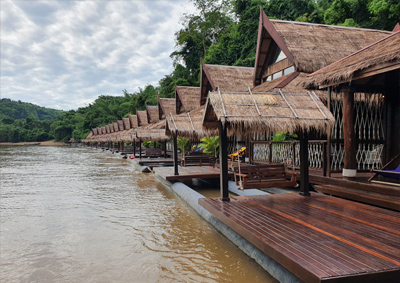 On the outskirts of Kanchanaburi there’s quite a few very interesting resorts by River Kwai’s banks that can be reached by boat. There’s the River Kwai Resotel, in the middle of the jungle, and the more expensive and famous Float House River Kwai Resort, where you can sleep in luxury cabins floating over the river. A least expensive option is the River Kwai Jungle Rafts, with simpler cabins over the river. Besides the charm of a quiet and scenic sleep over the river, all these resorts offer the simple but really fun activity of letting yourself float downstream with the only help of a life jacket. ¡Go with the flow!
On the outskirts of Kanchanaburi there’s quite a few very interesting resorts by River Kwai’s banks that can be reached by boat. There’s the River Kwai Resotel, in the middle of the jungle, and the more expensive and famous Float House River Kwai Resort, where you can sleep in luxury cabins floating over the river. A least expensive option is the River Kwai Jungle Rafts, with simpler cabins over the river. Besides the charm of a quiet and scenic sleep over the river, all these resorts offer the simple but really fun activity of letting yourself float downstream with the only help of a life jacket. ¡Go with the flow!
🏨 Where to stay in Kanchanaburi
Best City Areas to Stay:
In relation to the rather small size of Kanchanaburi, when choosing accommodation you should know that the city has a few well differentiated areas, and all of them can be a good option depending on what you’re looking for. The southern stretch of Mae Nam Khwae street is the most popular backpacker area, and the main party scene in town -noisy indeed-. The northern stretch of the same street is a quiet area across the river, but some might say a bit too far away from downtown. Downtown you’ll find a few good value guest houses, while the most fancy hotels and resorts are not found in Kanchanaburi itself but in its outskirts, with amazing views over the River Kwai.
South Mae Nam Khwae Rd.
 Best for: Backpackers and party lovers
Best for: Backpackers and party lovers
Accommodation available: Hostels
Advantages:
✔️ Cheap area
✔️ Lots of restaurants and bars
✔️ Party nightlife
✔️ Many travel agencies for backpackers
✔️ Riverside Location
North Mae Nam Khwae Rd.
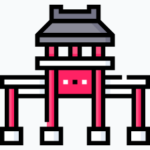 Best for: Quietness lovers
Best for: Quietness lovers
Accommodation available: Hostels and Hotels up to 4 star
Advantages:
✔️ Quiet area
✔️ Plenty of restaurants and Travel Agencies
✔️ Riverside Location
✔️ Near Bridge and Museums
Outskirts Riverside
 Best for: Luxury tourist
Best for: Luxury tourist
Accommodation available: 4 and 5 star hotels
Advantages:
✔️ Riverside Location with beautiful views
✔️ Up to 5 star luxury hotels
✔️ Some of them with floating rooms over the river
🧭 Itinerary to visit Kanchanaburi
One day is enough if you want to know the most relevant places of the town:
🗺️ Map of Kanchanaburi
On the following map you will find the location of all the places previously mentioned:
✈️ Arriving to Kanchanaburi
There are mainly 2 ways:
🚌 By bus or van: from Bangkok
From Bangkok, the main bus terminal connecting with Kanchanaburi is Sai Tai Mai –the Southern terminal–. There are bus departures every 20 minutes and vans every 30 minutes, between 04:00 and 20:00, the ticket costs 110/120 THB, and the journey usually takes a little over 3 hours. You can also go from Bangkok to Kanchanaburi from Mochit station – the Northern terminal – although here departures are less frequent: there are usually only a couple of buses a day, although every hour between 04:00 and 18:00 there are departures by van for 120 THB.
🚊 By Train: from Bangkok
Trains from Bangkok to Kanchanaburi do not depart from Hua Lamphong Central Station, but from Bangkok Noi Station, located in Thonburi -across the river- next to Siriraj Hospital. There are two daily departures, at 7:45 am and 1:55 pm, the ticket costs 100 THB, and the journey takes about 3 hours. Upon arrival, the central station is called Kanchanaburi and is located in the very center of the city, but if you are going to stay near the Bridge over the River Kwai you must get off at the next station, Saphan Kwai Yai… in this case be on the lookout for the last stretch, as the train crosses the famous bridge!
